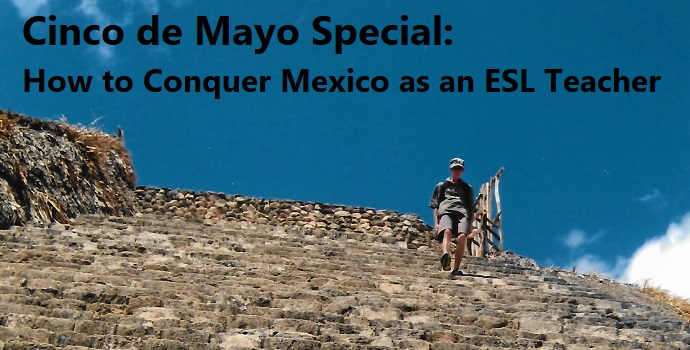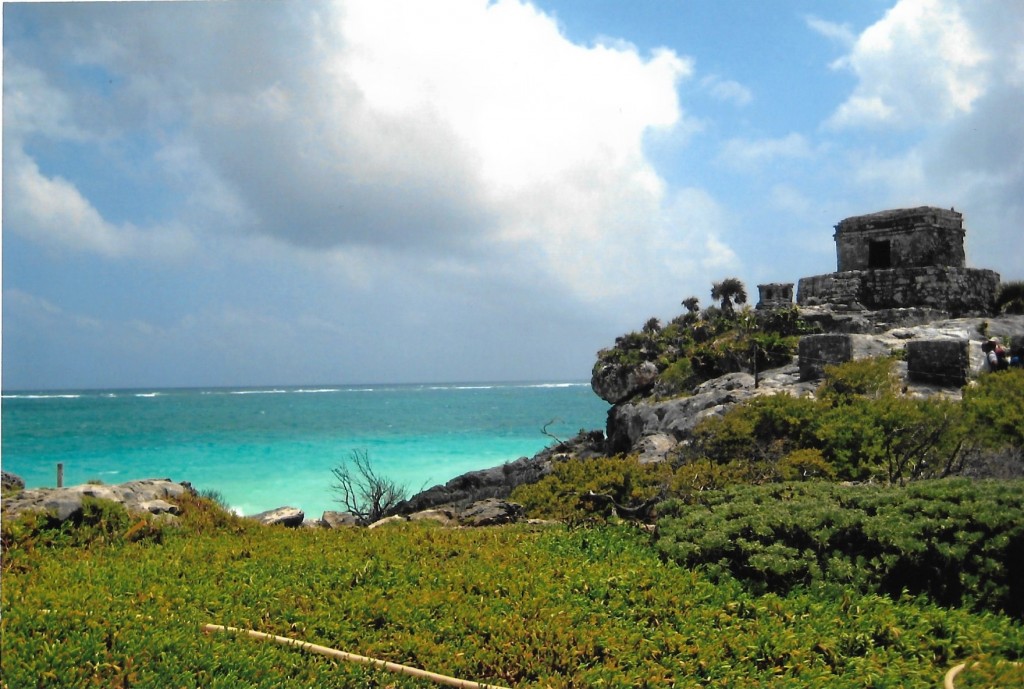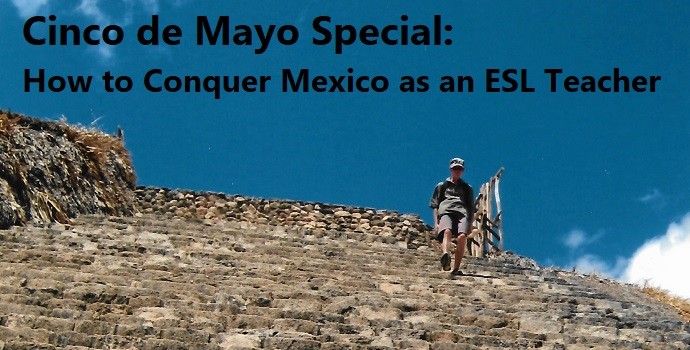
From the jungle-clad temples of Chiapas to the bustling streets and iconic roundabouts of Mexico City, Mexico truly has something for everyone. That being said, for those hungry to experience new cultures, languages, food, and adventures, the prospect of living and teaching English overseas can be both thrilling and intimidating. Most of us start off not knowing exactly where to go or what to expect, but our enthusiasm for venturing out into the great unknown outweighs our fear of leaving the comfort zone of friends, family and familiar places. I personally fell in love with the colonial architecture of Oaxaca City and the plush beaches of Tulum and the Maya Riviera, and in terms of teaching opportunities, I came to learn that Mexico offers teachers a wide variety of options. There are private K-12 schools, big language school chains, small independent language schools, corporate and business language schools, volunteer and homestay opportunities, and more. The country is also diverse in terms of geography and climate, the high mountainous plateaus get cold and dry in the winter, while the lowlands can be extremely hot and humid. If you are looking for a chance to experience all that Mexico has to offer, including teaching friendly and appreciative students, having some off-road adventures, spending some quality time at the beach and eating some delicious food, or you just want to improve your Spanish skills, then teaching English in Mexico should definitely be added to your own ‘must visit’ list!

The first place I taught in Mexico was a small public university in a town called Ixtepec, in the hot, southern lowlands of the state of Oaxaca. Ixtepec is known for its velas, annual festivals which start early in the morning, stretch late into the night, and go on for days at a time. The velas season is a time for singing, dancing, and catching up with neighbors as well as others in the community you might not normally run into. Another thing Ixtepec is known for is being a loading spot for The Beast. The Beast is the infamous moniker for the old cargo trains which ply Mexico’s rail lines, carrying cargo along tracks which have long ceased to be use for passenger trains. However, The Beast has also become one of the preferred forms of free transport for another form of unofficial cargo – migrants, most fleeing from Mexico’s neighbors to the south: El Salvador, Guatemala, Honduras and Nicaragua. These unofficial passengers hop on and off The Beast at different points along their journey, as they push north pursuing their dream of crossing through Mexico and making it to America.
One of my fellow teachers in Ixtepec told me about this when I first arrived, and also that there was a local refuge, supported by volunteers in the community, which provided the migrants with food, shelter, and whatever other donated supplies they could muster during their brief stopover in Ixtepec. This teacher also told me I could help volunteer to teach them some basic English, so we started going down to the refuge in the evenings after work. We would arrive at the tracks, which ran right through the centre of town, and we would watch The Beast chug into town against the backdrop of the fading evening sunset. On some nights there would be a dozen migrants, on some nights a couple dozen, but on busy nights there would be literally hundreds of people, lying on top of the train cars, standing on them, crouching, holding on between cars, even some hanging off the side of cars tied by their belts. As The Beast pulled up in town, the silhouettes of the migrants would scatter from the trains and disappear into the brush and woods along the edges of town.
Once the engine car had shunted off from Ixtepec to load up cargo, before returning and recoupling to continue the journey north, the migrants would make their way to the refuge and have a chance to rest, eat some food, and relax for the first time in days. Many did not want to talk about their experiences, but others were desperate to communicate the often-tragic stories of why they had taken up this quest, and the many dangers they had already encountered along the way. Most spoke little or no English, so I made up a worksheet with some essential survival vocabulary and phrases, things they could practice and use if they needed to ask for help from strangers, if and when they finally made it to the States.
Getting to meet these remarkable people, hear their stories, and see a human migration phenomenon like that firsthand was a life-changing experience I had never anticipated. It was also something I never could have planned for, since the migration routes change over time as certain regions become too dangerous and newer, safer routes temporarily emerge. Living, working, and getting to know people in a region you might otherwise never visit as a regular tourist, and certainly never remain in for long if you did, can produce some of the most surprising, memorable rewards of teaching English overseas. You might end up in a town, a country, even a continent you had never really planned on living in beforehand, and that might in fact lead to some of the most unbelievable experiences.
I stayed in Ixtepec for one year, and returned later for another year, by which time the migrant route had largely shifted to bypass Ixtepec and the surrounding region, as the area had become too dangerous for the highly vulnerable, generally undocumented migrants. I remained in Oaxaca for most of the next decade, and continued to teach English in other small, public universities in the sunny southern state. The university system there is called the SUNEO, and is comprised of almost 20 campuses spread out across the state. Most of the campuses are located in small towns, and a part of the goal of the system is to provide local students access to tertiary education that they may not otherwise have. Many, if not most of our students were the first of their family to go to university, so the experience was new and exciting for them, and for many of them it was the first time they were living away from home fending for themselves in the hurly-burly world of laundry, cooking, cleaning and grocery shopping. Despite some of the challenges of small, rural town living and working, I loved working with university students and I loved teaching in a public education system. The rewards of the job didn’t come in the form of fat paychecks, but rather from knowing you are playing your own small role in shaping and changing the lives of your students by providing them access to a new level of education and social and professional mobility.

Despite its spectacular scenery and world-class resorts, for some reason still unclear to me, Mexico was never a country that topped my personal must-see list. I never envisioned myself living and working there for nearly a decade, and I certainly never imagined I would buy my first car in Mexico, learn to speak fluent Spanish, meet lifelong friends and colleagues there, and come to think of it as a sort of ‘home away from home’. Looking back on it all now it seems strange to me that I was so unprepared for Mexico, and that nevertheless the country and culture embraced and welcomed me such warmth and humanity. My experience living and working in Mexico changed and enriched my life, and made me not only a better teacher, but a better person as well. That being said, the decision to move to Mexico to teach English was not made out of a search for such lofty ideals, but rather out of basic necessity.
When I first applied to go teach in Mexico, I was quickly running out of money while on a language course in the lovely seaside town of Nerja, Spain. Prior to that I’d been working in Canada for a couple years, saving up for a trip abroad, and since I wanted to improve my elementary level Spanish and also soak up some Mediterranean sun and sea breezes, Spain seemed like the perfect choice. The only downside was, my relatively meager savings weren’t going to last me very long once converted into Euro’s, and Spain on the Euro is a lot more expensive than Spain on the Spanish peso used to be. Similarly, English teaching opportunities for non-EU citizens have become much fewer and further between since EU integration.
Running out of money, and having done just the minimum amount of internet research, I started looking for teaching opportunities in Latin America. I had travelled in Ecuador and Peru already, but in terms of my prior knowledge of Mexico, I was basically starting from zero. Luckily, I was motivated and excited to try something new, and – despite serious lack of knowledge – in relatively short order I found and applied to a position teaching English to university students. To my pleasant surprise I was asked to do an interview by skype the following evening. I did my skype interview with the head of the languages department from a public phone booth I found in the touristy part of town, since this was way back in the days before everyone carried phones around in their pockets, or rather sticking out of their pockets. As it turned out, my future department head was a fellow Canadian from Quebec. We had a friendly yet professional interview, and several days later she offered me the position.
As I would later come to learn, these specific teaching jobs in Oaxacan universities were relatively easy to come by, since all the universities in the Oaxacan state system needed to have at least a few native speaker English teachers on staff, and the larger ones had up to 15 or 20 English teachers on staff. Also, because in Mexico the salaries are rather low compared to other popular teaching destinations in Asia and Europe, there was often a pretty high turnover rate. That, combined with the fact that all the campuses hired independently, meant you could always find a new campus to apply to if you decided to leave for a while and come back, or if you just wanted to experience life in another part of the state, trading mountain life for beach life, or vice versa.

Being a big of a migratory creature myself, it was nice to know you could pretty much always find a job within the Oaxacan state system, especially if you had taught with them before and proven yourself capable of adapting to the local conditions and being a dependable employee, colleague and teacher. It was also nice working at these schools because teachers got their own offices, which were spacious and bright. the hours were full-time, with a daily mixture of several teaching hours and several office hours. Although the salary wasn’t high by international standards, it afforded a good quality of life in Mexico, and in your office hours you had plenty of time to do all your lesson prep and marking, so there wasn’t any work to take home, or overtime required.
Another thing I liked about teaching at these small public universities was that the students were generally very appreciative of the fact that you had come to their small town or corner of the state to teach them, and they were curious about the big wide world beyond Mexico’s borders. Most hadn’t had the opportunity to travel much even within Mexico, let alone internationally, so they were fascinated by stories of living and working in other, seemingly exotic parts of the world like Asia and Europe. They also had great senses of humour and loved to laugh and socialize, which is very much part of Mexican and many Latin American cultures. A high value tends to be placed on relationships between family, friends and neighborhoods, and social events are often seen to be as – if not more – important than work or business obligations.
I also enjoyed working with university-age students, who are just at the end of their terrible teens and on the cusp of becoming adults. They are looking ahead to the start of their working lives and are nervously yet excitedly anticipating what their adult life might be like. As a teacher I appreciated working with students to whom you could give relatively elaborate tasks and assignments, then put them to work in pairs or groups, and watch them help one another learn as you move around the room facilitating and answering questions. One of my goals as a language teacher is always to try and inspire my students’ own intrinsic interest and motivation, since in my own experience learning Spanish, a key ingredient to the language learning recipe was my own internal desire to learn it and my drive to practice it.
Despite the relatively humble salaries and sometimes challenging living circumstances, I really fell in love with Mexico and consider it now to be a ‘home away from home.’ It’s an easy country and culture to come to love, and part of me always misses it and the friends I made there when I’m elsewhere. I would not hesitate to recommend it as a great destination for overseas English teachers. If making loads of cash isn’t your sole focus, but having an interesting and stimulating experience in a beautiful, warm country and culture is, then you might be surprised by just how much you come to love living and working far from the beaten tourist paths. The pace of life out there may be a bit slower and simpler than the hustle and bustle of the big resorts or the enticing capitals of Asia and Europe, but the experiences and memories might end up being some of your most cherished and lasting.
Al ex Yealland has taught English to students of all ages in Poland, Panama, South Korea, Taiwan and Mexico. Alex earned his Bachelor of Arts in philosophy from the University of Guelph, Canada, where he also completed graduate coursework in the Latin America and Caribbean Studies M.A. program. He has been teaching overseas for over 10 years, is a fluent Spanish speaker and has taught English at the university level in Mexico for 7 years. Alex is now putting his overseas work experience to good use, helping Oxford Seminars graduates find great teaching jobs as a member of the Job Placement Service.
ex Yealland has taught English to students of all ages in Poland, Panama, South Korea, Taiwan and Mexico. Alex earned his Bachelor of Arts in philosophy from the University of Guelph, Canada, where he also completed graduate coursework in the Latin America and Caribbean Studies M.A. program. He has been teaching overseas for over 10 years, is a fluent Spanish speaker and has taught English at the university level in Mexico for 7 years. Alex is now putting his overseas work experience to good use, helping Oxford Seminars graduates find great teaching jobs as a member of the Job Placement Service.



 Oxford Seminars Blog
Oxford Seminars Blog 








Great article Alex, You have certainly inspired my own great love for Mexico.